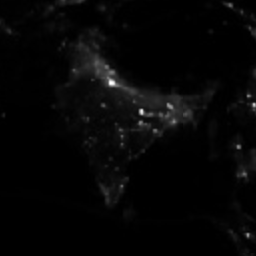Page Summary
-
The dataset provides meteorological forecasts of high-temporal frequency data from the NASA GEOS Composition Forecast (GEOS-CF) system.
-
GEOS-CF is a high-resolution global constituent prediction system that integrates the GEOS-Chem chemistry module.
-
The dataset includes hindcasts and 5-day forecasts for atmospheric constituents such as O3, CO, NO2, SO2, and PM2.5.
-
Evaluation shows realistic simulations for O3, NO2, and CO, but notes limitations with SO2 and summertime O3, and a general overestimation of aerosols.
-
The dataset is available from 2022-10-01 to 2025-10-15 and can be explored using Google Earth Engine.

- Dataset Availability
- 2022-10-01T00:00:00Z–2025-12-31T12:00:00Z
- Dataset Provider
- NASA / GMAO
- Tags
Description
This dataset contains meteorological forecast (fcst) of high-temporal frequency data (htf). Use the 'creation_time' and 'forecast_time' properties to select data of interest. The Goddard Earth Observing System Composition Forecast (GEOS-CF) system is a high-resolution (0.25°) global constituent prediction system from NASA's Global Modeling and Assimilation Office(GMAO).
GEOS-CF offers a new tool for atmospheric chemistry research, with the goal to supplement NASA's broad range of space-based and in-situ observations. GEOS-CF expands on the GEOS weather and aerosol modeling system by introducing the GEOS-Chem chemistry module to provide hindcasts and 5-days forecasts of atmospheric constituents including ozone (O3), carbon monoxide (CO), nitrogen dioxide (NO2), sulfur dioxide (SO2), and fine particulate matter (PM2.5). The chemistry module integrated in GEOS-CF is identical to the offline GEOS-Chem model and readily benefits from the innovations provided by the GEOS-Chem community.
Evaluation of GEOS-CF against satellite, ozonesonde, and surface observations for years 2018–2019 shows realistic simulated concentrations of O3, NO2, and CO, with normalized mean biases of −0.1 to 0.3, normalized root mean square errors between 0.1–0.4, and correlations between 0.3–0.8. Comparisons against surface observations highlight the successful representation of air pollutants in many regions of the world and during all seasons, yet also highlight current limitations, such as a global high bias in SO2 and an overprediction of summertime O3 over the Southeast United States.
GEOS-CF v1.0 generally overestimates aerosols by 20%–50% due to known issues in GEOS-Chem v12.0.1 that have been addressed in later versions. The 5-days forecasts have skill scores comparable to the 1-day hindcast. Model skills can be improved significantly by applying a bias-correction to the surface model output using a machine-learning approach.
Bands
Pixel Size
27750 meters
Bands
| Name | Units | Pixel Size | Description |
|---|---|---|---|
CO |
Mol fraction | meters | Carbon monoxide (CO, MW = 28.00 g mol-1) volume mixing ratio dry air |
NO2 |
Mol fraction | meters | Nitrogen dioxide (NO2, MW = 46.00 g mol-1) volume mixing ratio dry air |
O3 |
Mol fraction | meters | Ozone (O3, MW = 48.00 g mol-1) volume mixing ratio dry air |
PM25_RH35_GCC |
ug m-3 | meters | Particulate matter with diameter below 2.5 um RH 35 |
PM25_RH35_GOCART |
kg/m^3 | meters | Total reconstructed PM2.5 RH 35 |
Q |
Mass fraction | meters | Specific humidity |
RH |
meters | Relative humidity after moist |
|
SLP |
Pa | meters | Sea level pressure |
SO2 |
Mol fraction | meters | Sulfur dioxide (SO2, MW = 64.00 g mol-1) volume mixing ratio dry air |
T |
K | meters | Air temperature |
U |
m/s | meters | Eastward wind |
V |
m/s | meters | Northward wind |
Image Properties
Image Properties
| Name | Type | Description |
|---|---|---|
| creation_time | DOUBLE | Time of creation |
| forecast_time | DOUBLE | Forecast time |
Terms of Use
Terms of Use
Unless otherwise noted, all NASA-produced data may be used for any purpose without prior permission. For more information and exceptions visit the NASA Data & Information Policy page.
Citations
Keller, C. A., Knowland, K. E., Duncan, B. N., Liu, J., Anderson, D. C., Das, S., ... & Pawson, S. (2021). Description of the NASA GEOS composition forecast modeling system GEOS-CF v1. 0. Journal of Advances in Modeling Earth Systems, 13(4), e2020MS002413. doi:10.1029/2020MS002413
DOIs
Explore with Earth Engine
Code Editor (JavaScript)
var imageVisParamNO2 = { 'bands': ['NO2'], 'min': 6.96e-11, 'max': 4.42e-8, }; var imageVisParamT = { 'bands': ['T'], 'min': 220, 'max': 320, 'palette': ['d7191c', 'fdae61', 'ffffbf', 'abd9e9', '2c7bb6'], }; var geosCf = ee.ImageCollection('NASA/GEOS-CF/v1/fcst/htf'); Map.setCenter(100, 20, 3); var weeklyT = geosCf.select('T').filterDate('2022-11-01', '2022-11-08').median(); Map.addLayer(weeklyT, imageVisParamT, 'Weekly T', false, 1); var NO2 = ee.Image('NASA/GEOS-CF/v1/fcst/htf/20221215_12z-20221216_1200z'); Map.addLayer(NO2, imageVisParamNO2, 'NO2', true, 1);